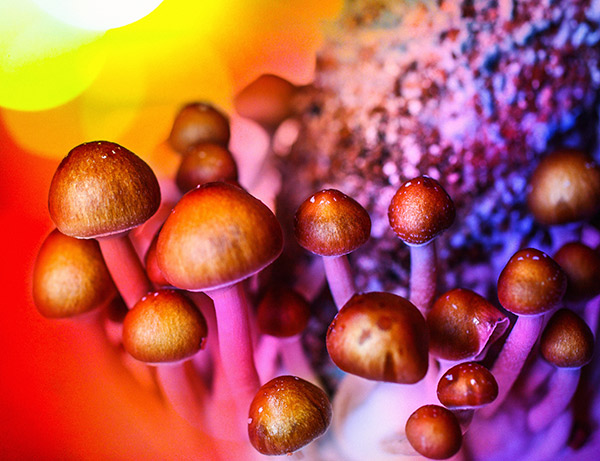The hallucinogenic drug, psilocybin, which is present in a number of species of mushroom, is particularly interesting to scientists as it may have potential use in the treatment of a variety of neuropsychiatric disorders. However, the mechanism by which the chemical works in the brain isn’t well understood. Scientists at Johns Hopkins University School of Medicine now report on brain imaging studies in human volunteers that have shown how psilocybin alters signaling in a somewhat enigmatic region of the brain known as the claustrum, which is derived from the Latin word for “hidden” or “shut away.”
“Our findings move us one step closer to understanding mechanisms underlying how psilocybin works in the brain,” said Frederick Barrett, PhD, assistant professor of psychiatry and behavioral sciences at the Johns Hopkins University School of Medicine and a member of the school’s Center for Psychedelic and Consciousness Research. “This will hopefully enable us to better understand why it’s an effective therapy for certain psychiatric disorders, which might help us tailor therapies to help people more.”
Barrett and colleagues reported their findings in NeuroImage, in a paper titled, “Psilocybin acutely alters the functional connectivity of the claustrum with brain networks that support perception, memory, and attention.”
The claustrum is an extremely thin sheet of neurons deep within the cortex, yet it reaches out to every other region of the brain. Its true purpose also remains “hidden away,” with researchers speculating about many functions. Francis Crick, for example, believed the claustrum to be the seat of consciousness, responsible for awareness and sense of self.
What is known is that this region contains a large number of receptors targeted by psychedelic drugs such as LSD or psilocybin, a chemical that acts as a serotonin 2a (5-HT2A) receptor partial agonist. Psilocybin alters sensory perception, but it may have long-term therapeutic value in treating a range of neuropsychiatric disorders, without the adverse reactions associated with current medication, the team noted. “Understanding how psilocybin alters large-scale brain networks may reveal mechanisms of therapeutic effects and shed light on new therapeutic targets for many mental disorders. The effects of psilocybin are largely achieved through its action as a partial agonist of the serotonin 2a (5-HT2A) receptor which likely modulates glutamatergic signaling across a range of cortical and subcortical afferents.”
Because of its deep-seated location in the brain, the claustrum has been difficult to access and study. Last year, however, Barrett and his colleagues at the University of Maryland, Baltimore, developed a method to detect brain activity in the claustrum using functional magnetic resonance imaging (fMRI). To see what happened in the claustrum when people were given the psychedelic, the Johns Hopkins Medicine researchers compared the brain scans of 15 healthy volunteers both before, and after they took psilocybin, or a placebo. The participants all received psychological support before, during, and after drug administration and scanning procedures, consistent with guidelines for the safe administration of psilocybin in a research context.
The scans indicated that psilocybin reduced neural activity in the claustrum by 15–30%, suggesting that the area of the brain that is believed to be responsible for setting attention and switching tasks is turned down in response to the drug. “Psilocybin reduced measures of activity (variance and amplitude of low-frequency fluctuations) of both left and right claustrum during the acute effects of psilocybin, and led to alterations in both left and right claustrum connectivity with brain networks that support sensory and cognitive processes,” the researchers wrote. They say that this ties in with what people report as typical effects of psychedelic drugs, including feelings of being connected to everything and reduced senses of self or ego.
Lowered activity in the claustrum also appeared to be associated with stronger subjective effects of the drug, such as emotional and mystical experiences. The researchers in addition found that psilocybin changed the way that the claustrum communicated with brain regions involved in hearing, attention, decision-making, and remembering.
The authors acknowledged that their study did have a number of limitations, and suggested future directions for research, noting that reductions in the volume of the claustrum have been reported in depression and schizophrenia. “The current report utilizes a pharmacological intervention to provide empirical evidence for a significant role of 5-HT2A signaling in claustrum function, provides evidence for the potential effects of psilocybin on claustrum activity and connectivity, and highlights the need for additional efforts to further explore the potential role of the claustrum in both the subjective and therapeutic effects of psilocybin,” they concluded.
With the highly detailed imaging of the claustrum provided by fMRI, the researchers next hope to further investigate this brain region in people with certain psychiatric disorders such as depression and substance use disorder. Their aim will be to see what roles, if any, the claustrum plays in these conditions. The researchers also plan to observe the claustrum’s activity when under the influence of other psychedelics, such as salvinorin A, a hallucinogen derived from a Mexican plant.




